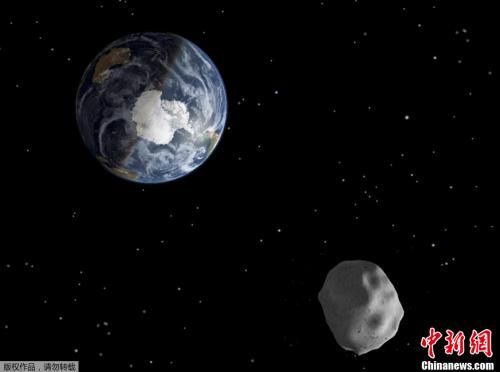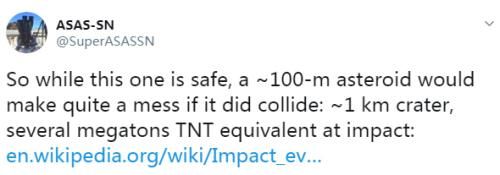闭目养神
如果你不幸进来了,你会失望。如果在这里,你学到点什么,或有什么感受,那更是浪费你的时间了,咳,咳!一颗命名为“2019 OK”的小行星,以不足地球月球距离五分之一的距离,在八月二日从地球“擦身而过”。它几乎是在最后时刻被发现的。而发现这颗小行星的是三位巴西的天文科学家。因为发现的很仓促,着实让天文学家们惊出一身冷汗。但是经过NASA(美国国家航空航天局),ESA(欧洲航天局)还有巴西、澳大利亚等 ISON(the International Scientific Optical Network )的天文学家们通力合作,在极短时间内将小行星的运行轨道计算出来,预测无危害通过。下一次再会是2024年,但距离会很远。
NASA,ESA 和 ISON 等组织对与地球规定有重合的小行星们的观测,已经有好多年了。这些活动,除了预报危害外,还可以(据提案)对具有严重威胁的小行星发射火箭冲撞,迫使其改变轨道。数年前,NASA曾发射一枚飞船着陆在类似的一颗(足球场大小的)小行星上,对起经常探测。所以用火箭碰撞改变小行星轨道的提案也是有依可据的。
这才是“人类命运共同体”的一个实例。
下面内容来自中文媒体的报道:
威力可摧毁两个纽约!一颗小行星差点撞上地球(图) (http://www.hi.chinanews.com/hnnew/2019-08-02/497086.html)(部分内容见下):
中新网8月2日电 (李弘宇)近日,在很多人都不知情的情况下,一颗名为“2019 OK”的小行星以大约8.7万公里每小时的速度,在不足五分之一的地月距离处掠过地球,令天文学家们着实“捏了把汗”。
虽然美国国家航空航天局(NASA)一直密切跟踪大型小行星,以识别那些可能对地球构成威胁的小行星,但这颗威力足以夷平一整座城市的小行星,却直到其接近地球的前一天,才被天文学家们发现。在此之前,人类对它一无所知。
天文学家先前已经预测到,近期会有几颗小行星通过地球。可为何这颗小行星,直到最后一刻才被发现?
与地球擦肩而过
为何前一天才被发现?
澳大利亚蒙纳士大学天文学副教授迈克·布朗称,“小行星‘2019 OK’不是我们追踪的星体,不知道它到底从哪里冒出来”,“它可能是这么多年来,如此接近地球的行星之中,体积最大的一颗。”
外媒报道称,这颗小行星直径大约在“57米至130米之间”,而现在服役的最大客机(空中客车A380-800)也才长约73米。在浩瀚宇宙中发现这颗小行星,就如在太空中找到一架大型客机,难度可想而知。
布朗表示,“2019 OK”过去1个月里,非常靠近太阳,夜晚时,与太阳一同落到地平线下,因此观测不到。天文学家们只有黄昏与黎明的时候,在太阳刚刚落入地平线以下,小行星还在地平线以上时,才可能察觉其微弱亮度。
据报道,“2019 OK”从地球身旁掠过的3天前,亮度比平时还要黯淡1000倍,所以天文学家与观测站的天文望远镜都没能及时发现它。

图为NASA发布的拍摄于2013年2月15日阿根廷境内的小行星掠过地球的图像。
若撞地球后果多严重?
或是广岛原子弹爆炸能量30倍
如果地球被“2019 OK”撞上,将产生什么后果?1908年,一颗直径比“2019 OK”还要小的小行星,在西伯利亚通古斯河附近发生爆炸,将几乎是两个纽约市大小的森林夷为平地。
澳大利亚斯威本科技大学天文学家艾伦·达菲称,“若撞击地球,其威力或超过广岛原子弹爆炸能量的30倍”,它是一个“城市毁灭者”。布朗表示,它就像是个“非常巨型的核武器”,威力足以摧毁一座城市,不容小觑。
美国全天自动超新星勘测项目(ASAS-SN)团队在社交媒体上发文称,虽然这颗小行星是安全的,但“一颗直径为100米的小行星若与地球相撞,会造成相当大的影响:制造直径约1公里的陨石坑,威力或相当于几百万吨的TNT炸药当量。”

ASAS-SN在社交媒体上发文称,直径为100米的小行星若与地球碰撞,会造成相当大的影响:制造直径约1公里的陨石坑,威力或相当于几百万吨的TNT炸药当量。”(图片来源:ASAS-SN社交媒体截图)
据报道,天文学家们过去曾发现数以千计的近地小行星,但很少有像“2019 OK”那样接近地球。达菲表示,“我当时惊呆了,真实地受到惊吓……小行星的距离近到让人很不安。”
有研究称,直径超过1公里的近地小行星,都能够产生毁灭性的破坏力,比地球上现存核武库里所有军火爆炸的威力,还要高百倍甚至千倍。
6500万年前,一颗直径逾10公里的小行星撞上地球,在墨西哥尤卡坦半岛造成巨大的“希克苏鲁伯陨石坑”,被认为是导致全球气候剧变、恐龙灭绝的直接原因。
2013年2月15日,一颗直径约20米的小行星在穿越大气层时摩擦燃烧,在俄罗斯车里雅宾克斯地区上空爆炸,致使近3000座建筑受损,1200人受伤。
=====================
来自英文媒体的报道:
Big Asteroid Buzzed Past Earth Last Week: 2019 OK
A 330-foot- (100 m) wide asteroid designated 2019 OK passed just 43,500 miles (70,000 km) from Earth on July 25, 2019. It was discovered by the Brazilian SONEAR survey just days ago, and its presence was announced mere hours before it zoomed past our planet. 2019 OK is not a threat to Earth right now. However, this and other near-Earth asteroids do pose a genuine risk. The Tunguska explosion in 1908 and the Chelyabinsk meteor in 2013 were equivalent to large nuclear explosions, and under the wrong circumstances a meteor impact could devastate a city.
Searching for danger
Astronomers are well aware of the risks posed by asteroids hitting Earth. Meteor craters can be found around the globe, and some relatively fresh examples include Wolfe Creek in northern Australia and the imaginatively named Meteor Crater in Arizona. A huge asteroid impact 65 million years ago near Chicxulub in modern-day Mexico initiated the fall of the dinosaurs.
Consequently, astronomers across the globe have devoted considerable effort to determining the level of threat posed by near-Earth asteroids, and to identifying individual asteroids that could pose a significant threat. Asteroid surveys include Pan-STARRS, ATLAS, SONEAR, and the Catalina Sky Survey.
Asteroids are typically so far from Earth that they resemble stars, rather than the craggy rocks they are. However, because asteroids travel around the Solar System, they move relative to the distant stars. Thus astronomers can discover asteroids by taking sequences of images and looking for objects that move from image to image.
Using this approach to survey large swathes of sky, astronomers have discovered thousands of near-Earth asteroids, including more than 2,000 during 2017 alone.
And yet, some asteroids still manage to sneak up on us. Why?
Astronomers are good at discovering asteroids that are visible at night, but less good at spotting asteroids during the daytime. Asteroids also are fainter the further they get from Earth.
The 2013 Chelyabinsk meteor snuck up on us from the direction of the Sun. 2019 OK was visible at night, and at closest approach it would have been visible with a pair of binoculars as point of light drifting slowly across the sky. But three days before that it was 1,000 times fainter, and thus harder to spot.
2019 OK was finally tracked down by the SONEAR survey on Wednesday, and soon after that it was independently detected by the ASAS-SN telescope network. Both of these surveys use relatively small telescopes with sensitive cameras to search large areas of sky, rather than using large telescopes to study small patches of sky.

Trees flattened by the intense shock wave created in the atmosphere as the space rock exploded above Tunguska on June 30, 1908. The photograph was taken by the Soviet Academy of Science 1929 expedition led by Leonid Kulik. 500,000 acres, the size of a large metropolitan city, were flattened. Flattening trees requires an immense shock wave.
Close calls
Before its discovery as a near-Earth asteroid, 2019 OK was imaged by other telescopes, but its significance wasn’t recognised. But these earlier images did help astronomers nail down the asteroid’s orbit.
2019 OK has a very elliptical orbit, taking it from the asteroid belt beyond Mars to within the orbits of both Earth and Venus. As each orbit takes 2.7 years, it isn’t always going to pass as close to Earth as it did this time. It will make close approaches in the future, but hopefully not quite this close.
Other near-Earth asteroids are also on track to make close approaches to our planet. The 1,312-foot- (400 m) wide Apophis will pass roughly 18,700 miles (30,000 km) from Earth on Friday April 13, 2029, which will only come as bad news if you’re particularly superstitious.
Both 2019 OK and Apophis are far larger than the Chelyabinsk meteor, which was just 66 feet (20 m) across. The risk of them hitting Earth may be small, but they would be devastating if they did.
Avoiding Armageddon
If we find an asteroid on an actual collision course with Earth, is there anything we can do? With just a day or week’s notice we would be in real trouble, but with more notice there are options.
We are already sending spacecraft to near-Earth asteroids, with NASA’s OSIRIS-REx currently visiting Bennu and Japan’s Hayabusa2 currently visiting Ryugu.
However, these are missions of discovery rather than destruction. Indeed, destroying a near-Earth asteroid may be counterproductive, potentially creating multiple destructive asteroids.
So how can we stop catastrophe? The solution may be to give dangerous asteroids a gentle nudge rather than a vicious kick. If an asteroid’s velocity can be changed by just 0.6 mph (1 kmh), over years that adds up to thousands of miles’ difference in position. Given that the pale blue dot of Earth is just 8,000 miles (12,750 km) across, a small nudge to a big rock may be enough to avoid annihilation.
_____
J. Bulger et al. 2019. 2019 OK. Minor Planet Electronic Circular # 2019-O56

Author: Michael J.I. Brown, associate professor in astronomy at Monash University.
This article was originally published on The Conversation.





